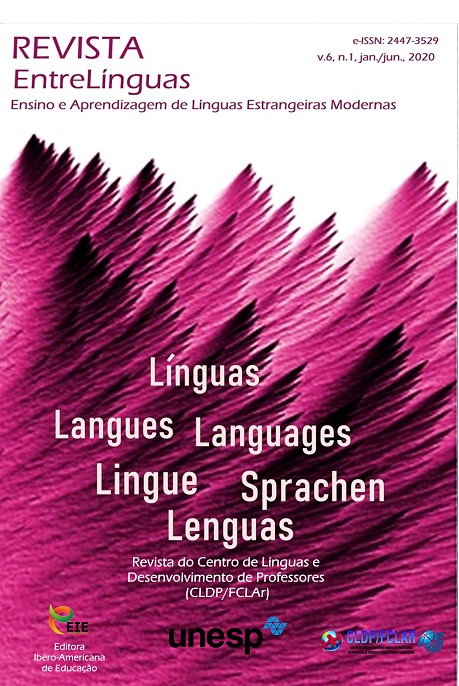Spanish geographical varieties recognition by sfl students from Slovakia,Czech Republic and Poland
DOI:
https://doi.org/10.29051/el.v6i1.13318Keywords:
Spanish varieties, Spanish as a foreign language, Identification of the varieties, Social imaginaries, PRECAVES XXI.Abstract
The present paper examines the identification and categorization of Spanish geographical varieties by SFL students from the Bilingual Sections of Slovakia, the Czech Republic and Poland. In addition, the factors that may influence this recognition are discussed, as well as the social imaginaries and prototypes for each variety. The PRECAVES XXI project survey and recordings are used for data collection. After analyzing the participants' responses, we found that the varieties that were easiest to identify were Castilian, Rioplatense, Andalusian and Mexican, while the others (Canarian, Caribbean, Andean and Chilean) showed a very low level of recognition. Furthermore, it was found that the imaginaries vary depending on the variety, showing that each one of them works independently.Downloads
References
BAKER, W.; EDDINGTON, D.; NAY, L. Dialect identification: the effects of region of origin and amount of experience. American Speech, v. 84, n. 1, p. 48-71, 2009.
CARAVEDO, R. Variación y cambio desde una perspectiva sociocognitiva. In: CONGRESO INTERNACIONAL DE HISTORIA DE LA LENGUA ESPAÑOLA, 10., 2015. Zaragoza. Anais [...]. Zaragoza: Institución Fernando el Católico, 7-11 set. 2015. p. 67-96.
CESTERO, A. M. y PAREDES, F. Creencias y actitudes hacia las variedades cultas del español actual: el proyecto PRECAVES XXI. Boletín de Filología de la Universidad de Chile, v. 53, n. 2, p. 11-43, 2018.
CHIQUITO, A.; QUESADA PACHECO, M. Actitudes lingüísticas de los hispanohablantes hacia el idioma español y sus variantes. Bergen: University of Bergen, 2014.
CLOPPER, C. G.; PISONI, D. B. Homebodies and army brats: some effects of early linguistic experience and residential history on dialect categorization. Language Variation and Change, v. 16, n. 1, p. 31-48, 2004.
CUNNINGHAM-ANDERSSON, U. Learning to interpret sociodialectal cues. Speech, Music and Hearing: Quarterly Progress and Status Report, v. 37, n. 2, p. 155-158, 1996.
DEPARTAMENTO DE LINGÜÍSTICA. CESTERO, A. M.; F. PAREDES. (Coords.). Percepción de las variedades cultas del español: creencias y actitudes de jóvenes universitarios hispanohablantes. Monográfico del Boletín de Filología, Universidad de Chile, v. 53, n. 2, 2018.
DÍAZ-CAMPOS, M.; NAVARRO-GALISTEO, I. Perceptual categorization of dialect variation in Spanish. In: Collentine, J. et al. (Coords.). Selected proceedings of the 11th Hispanic linguistics symposium. Somerville, MA: Cascadilla Proceedings Project. 2009. p. 179-195
FERNÁNDEZ MARTÍN, P. La conciencia lingüística en el aula de ELE: lengua artificial, lengua natural y diversidad sociolingüística. Revista Internacional de Lenguas Extranjeras, n. 3, 31-61, 2014.
GARCÍA, Á. L. Los conceptos de lengua y dialecto a la luz de la teoría de prototipos. La Torre: Revista de la Universidad de Puerto Rico, v. 3, n. 7, p. 7-19, 1998.
GOOSKENS, C. How well can Norwegians identify their dialects? Nordic Journal of Linguistics, v. 28, n. 1, p. 37-60, 2005.
MINISTERIO DE EDUCACIÓN, CULTURA Y DEPORTE. Currículo de lengua y literatura españolas. Cursos III, IV y V. Secciones Bilingües de Eslovaquia. Secretaría General Técnica del MECD, Subdirección General de Información y Publicaciones, 2016.
MINISTERIO DE EDUCACIÓN Y CIENCIA, SECRETARÍA GENERAL TÉCNICA. Currículo de lengua y literatura españolas. Secciones Bilingües en la República Checa. Secretaría General Técnica. Centro de Publicaciones. Agregaduría de Educación en la República Checa, 2007.
MINISTERIO DE EDUCACIÓN Y FORMACIÓN PROFESIONAL. (s.f.a) Currículo de Lengua y Literatura Españolas. Secciones Bilingües de español. Polonia. Disponible em: https://www.educacionyfp.gob.es/polonia/dam/jcr:54ed989c-2c84-4a96-8367-02459a3c551d/curriculo-l-literat2011-12.pdf. Acceso el: 15 maio 2019.
MINISTERIO DE EDUCACIÓN Y FORMACIÓN PROFESIONAL. (s.f.b). Secciones bilingües en Europa central y oriental, China y Turquía. Disponible em: http://www.educacionyfp.gob.es/en/contenidos/ba/actividad-internacional/oficinas-centro-exterior/centros-docentes/seccione-bilingue-europa.html. Acceso el: 10 jun. 2019.
MORENO FERNÁNDEZ, F. Prototipos y prestigio en los modelos de español. Carabela. Modelos de uso de la lengua española, n. 50, p. 5-20, 2001.
MORENO FERNÁNDEZ, F. Variedades del español y evaluación. Opiniones lingüísticas de los anglohablantes. Informes del Observatorio/Observatory Reports, p. 1-53, 2017.
MORENO FERNÁNDEZ, F. La lengua española en su geografía: manual de dialectología hispânica. 4. ed. Madrid: Arco/Libros, 2019.
SCHOONMAKER-GATES, E. Dialect comprehension and identification in L2 Spanish: Familiarity and type of exposure. Studies in Hispanic and Lusophone Linguistics, v. 11, n. 1, p. 193-214, 2018.
VAN BEZOOIJEN, R.; GOOSKENS, C. Identification of language varieties: the contribution of different linguistic levels. Journal of language and social psychology, v. 18, n. 1, p. 31-48, 1999.
WILLIAMS, A.; GARRETT, P.; COUPLAND, N. Dialect Recognition. In: PRESTON, D. R. (Coord.). Handbook of perceptual dialectology. Vol. 1). Amsterdam/Philadelphia: John Benjamins Publishing Company, 1999. p. 345-358.
Published
How to Cite
Issue
Section
License
Os manuscritos aceitos e publicados são de propriedade da Revista EntreLínguas. Os artigos publicados e as referências citadas na Revista EntreLínguas são de inteira responsabilidade de seus autores.
Transferência de direitos autorais – autorização para publicação
Caso o artigo submetido seja aprovado para publicação, já fica acordado que o(s) autor(es) autoriza(m) a UNESP a reproduzi-lo e publicá-lo na EntreLínguas, entendendo-se os termos “reprodução” e “publicação” conforme definição respectivamente dos incisos VI e I do artigo 5° da Lei 9610/98. O artigo poderá ser acessado pela rede mundial de computadores (Internet), sendo permitidas, a título gratuito, a consulta e a reprodução de exemplar do artigo para uso próprio de quem a consulta, desde que haja a citação ao texto consultado. Essa autorização de publicação 328 EntreLínguas, Araraquara, v. 1, n .2, p. 323-328, jul./dez. 2015 não tem limitação de tempo, ficando a UNESP responsável pela manutenção da identificação do(s) autor(es) do artigo. Os artigos publicados e as referências citadas na Revista EntreLínguas são de inteira responsabilidade de seus autores.











